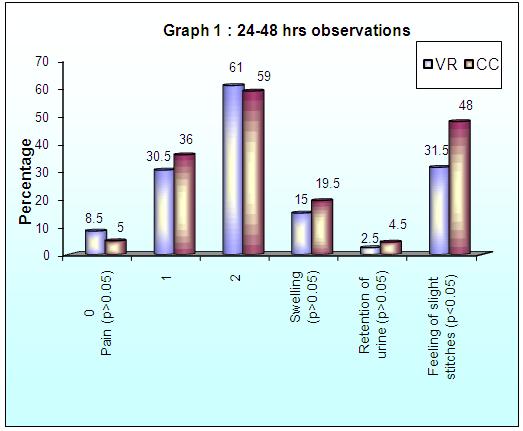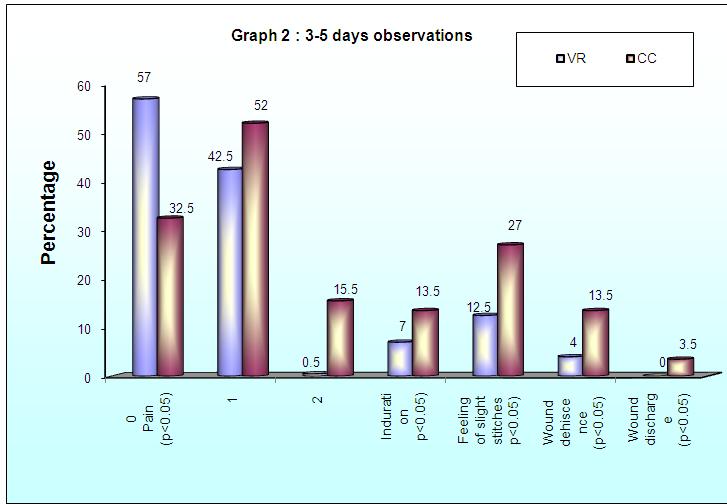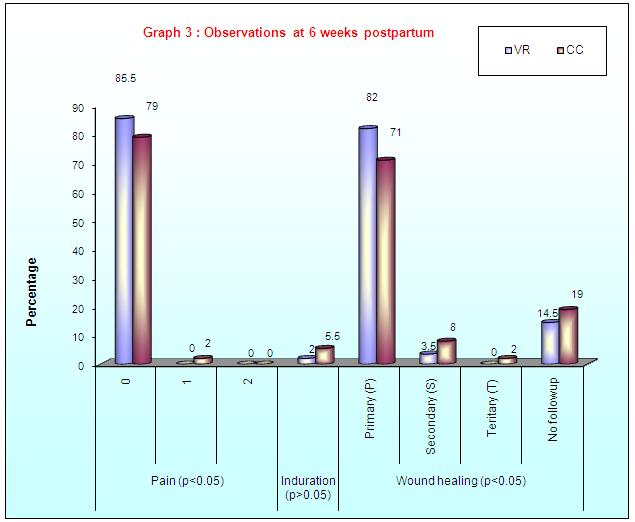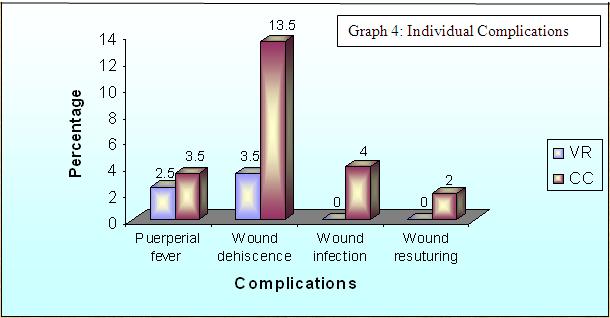Episiotomy is a surgical incision which is made in the perineum to enlarge the vaginal opening for birth and one of the most commonly performed procedures in obstetrics. The two most common types of episiotomies which are made are the midline or median and the mediolateral. The purpose of this procedure was to facilitate the completion of the second stage of labour to improve both the maternal and the neonatal outcomes. The maternal benefits were thought to include a reduced risk of perineal trauma, subsequent pelvic floor dysfunction and prolapse, urinary incontinence, faecal incontinence, and sexual dysfunction. The potential benefits to the foetus were thought to include a shortened second stage of labour, which would result from a more rapid spontaneous delivery or from an instrumental vaginal delivery.
Though episiotomy is known to have maternal benefits, a substantial portion of both the short and long term postpartum morbidities is attributed to the perineal pain which is secondary to the episiotomy and the lacerations and their repair. The immediate consequences include blood loss, perineal pain, oedema, infection and hematoma and wound dehiscence. Others include an extension to 3rd or 4th degree lacerations. The long term complications include the formation of scar tissue, wound infections and dyspareunia. The factors which may influence the extent of any subsequent morbidity include the type of suture material which is used, the suturing technique and the skill of the operator. Debate flourishes among the practitioners about the appropriate material which should be used. The newer polyglycolic acid suture materials elicit less inflammatory tissue response than chromic catgut [1]. The use of synthetic materials in the perineal repairs reduce the postpartum pain and it also provides a better wound healing [2].
The present study was designed to study the two different suture materials, namely, vicrylrapide and chromic catgut for episiotomy repair, in relation to a short term maternal morbidity.
MATERIALS AND METHODS
This “prospective, randomized, comparative study” of vicrylrapide versus chromic catgut for episiotomy repair” was conducted in the Department of Obstetrics and Gynaecology of the teaching hospitals which were attached to J.J.M. Medical College, Davangere. In this study, four hundred women who were given episiotomies following spontaneous or instrumental deliveries, who were admitted to the labour rooms of Bapuji Hospital, Chigateri District Hospital and Women and Children Hospital, were included.
The women with episiotomies following spontaneous or instrumental deliveries, were enrolled for the study, as and when they were presented consecutively with the following exclusion criteria. The enrolled women were randomly allocated to a repair with either vicrylrapide or chromic catgut. The randomization was done by providing the patient two coins, red- which indicated vicrylrapide and blue –which indicated chromic catgut and allowing them to choose their coin. Accordingly, they were sutured with the respective suture material.
The patients were distributed in two groups, A and B. Group A: Two hundred patients who were sutured with vicrylrapide 2-0 and group B: Two hundred patients who were sutured with chromic catgut 1-0..
Inclusion Criteria: The women with episiotomies following spontaneous or instrumental deliveries, were enrolled for the study.
Exclusion Criteria: The women with intrapartum fever, perineal tears, cervical tears, vaginal tears, extension of the episiotomies, severe preeclampsia, severe anaemia, a previous perineal surgery other than the primary repair after child birth, HIV or the hepatitis B infection and a dead foetus and the cases which were handled outside.
The women who fulfilled the above criteria underwent an episiotomy suturing, either with vicrylrapide 2-0 (36 mm ½ circle double reverse cutting and round bodied needle) or chromic catgut 1-0 (30mm,1/2 circle round bodied needle). All the episiotomies were right mediolateral. The episiotomies were repaired by a standard three-step approach. The vaginal mucosa was sutured by using a continuous interlocking suture and the perineal muscle was sutured by using an intermittent suture. The skin closure was done by using a mattress suture. Both the groups were compared in terms of the age, parity, presentation and the period of gestation. The time between the giving of the episiotomy and the suturing was noted. The quantity of the local anaesthetic which was used (2% lignocaine hydrochloride) and the time which was taken for the suturing were also noted. Diclofenac sodium was used as an analgesic in this study. All these parameters were compared between the two groups for any significant differences.
Both the groups were assessed at 24-48 hrs, on days 3-5 and at 6 weeks postpartum. The main outcome measures which were recorded were (1) 24 to 48 hours: Perineal pain, temperature, swelling, retention of urine and feeling of slight stitches (2) Days 3 to 5: Pain, temperature, indurations, wound discharge, wound disruption or dehiscence and feeling of slight stitches (3) Six weeks postpartum Perineal pain, temperature, wound indurations, wound dehiscence and healing by primary, secondary and tertiary intentions. The pain was measured by using an oral analogue scale. The absence of pain, presence of pain and the patients’ desire for more analgesics, were rated as 0, 1 and 2 respectively. The wound infection was assessed clinically with the following markers- throbbing pain in the perineum, a local rise in temperature, swelling and discharge from the wound.
STATISTICAL ANALYSIS
The descriptive data were presented as number and percentages with mean and standard deviations, wherever required. The Chisquare test was used for analyzing the categorical data. The “Z” test was used for comparing the means between the two groups. A p-value of 0.05 or less was considered to be statistically significant.
RESULTS
This study was conducted on four hundred women who were admitted to the Department of Obstetrics and Gynaecology, JJMMC and to the three hospitals which were attached to it. The enrolled women were divided into 2 groups.
Group A: Vicrylrapide and Group B: Chromic Catgut. Both the groups were comparable in terms of the age, parity, presentation, period of gestation, mode of delivery, the duration of the second stage and birth weight [Table/Fig-1]. The time between the giving of the episiotomy and the suturing was noted. The quantity of the local anaesthetic which was used was approximately 9.6 cc [Table/Fig-2]. The episiotomies were sutured by both house surgeons and postgraduates. The time which was taken for the suturing with vicrylrapide was slightly more, because more number of knots were required.
Details of groups at trial entry
| Particulars | Vicrylrapide (N = 200) | Chromic catgut (N = 200) | |
|---|
| AGE | Mean age±SD years | 21.5±2.7 | 21.6±2.8 | Z = 0.36, p > 0.05 NS |
| Range | 18-32 | 18-35 |
| Gravida | G1 | 147 (73.5%) | 144 (72%) | x2 = 0.27, p > 0.05, NS |
| G2 | 36 (18%) | 40 (20%) |
| G3 | 12 (6%) | 15 (7.5%) |
| G4 | 5 (2.5%) | 1 (0.5%) |
| Anc Care | Booked | 189 (94.5%) | 179 (89.5%) | x2 = 3.40, p > 0.05, NS |
| Unbooked | 11 (5.5%) | 21 (10.5%) |
| Period of gestation | Term | 188 (94%) | 192 (96%) | x2 = 3.40, p > 0.05, NS |
| Preterm | 11 (5.5%) | 4 (2%) |
| Post-term | 1 (0.5%) | 4 (2%) |
| Presentation | Vertex (Vx) | 198 (99%) | 198 (99%) | x2 = 3.40, p > 0.05, NS |
| Breech | 2 (1%) | 2 (1%) |
| H/O episiotomy | Present | 24 (12%) | 25 (12.5%) | x2 = 0.02, p > 0.05, NS |
| Mode of delivery | Spontaneous | 190 (95%) | 185 (92.5%) | x2 = 1.18, p > 0.05, NS |
| Forceps | 6 (3%) | 10 (5%) |
| Vacuum | 4 (2%) | 5 (2.5%) |
| Second stage duration | Mean±SD (mins) | 29.9±13.9 | 27.7±15.3 | Z = 1.51, p > 0.05, NS |
| Range | 10-100 | 5-110 |
| Birth weight (kg) | Mean ± 2SD | 2.6 ± 0.40 | 2.61 ± 0.39 | Z = 0.25, p > 0.05, NS |
| Range | 1.25 - 3.6 | 1.25 - 3.8 |
Parameters assessed in episiotomy suturing
| Parameter | | Vicryl Rapide N (%) | Chromic Catgut -N (%) |
|---|
| Time between episiotomy and Suturing (min) | Mean ± SD | 36.2 ± 4.3 | 36.3 ±4.8 |
| Range | 25 – 50 | 25 – 50 |
| Z = o.219 , p > 0.05 NS |
| Quantity of LA used (ml) | Mean ± SD | 9.6 ± 0.8 | 9.7 ± 0.8 |
| Range | 8 – 10 | 5 – 10 |
| Z = 1.25 , p > 0.05 NS |
| Time taken for suturing | Mean ± SD | 18.7 ± 2.2 | 14.7 ±2.2 |
| Range | 14 – 25 | 10 – 20 |
| Z = 18.2, p < 0.05 S |
| Technique 1) Interrupted | | 200 (100) | 200 (100) |
| 2) Mattress | | 200 (100) | 200 (100) |
A feeling of slight stitches (uncomfortable stitches) was observed in 31.5% of the cases in the VICRYL RAPIDE group and in 48% of the cases in the CHROMIC CATGUT group, which was statistically significant. Even though the pain score, indurations and the retention of urine were less in the VICRYL RAPIDE group, it was not statistically significant [Table/Fig-3].

The women in the VICRYL RAPIDE group had less perineal pain, wound indurations (7% vs 13.5%), wound dehiscence (4% vs 13.5%) and wound discharge (0% vs 3.5%), as compared to those in the CHROMIC CATGUT group, which was statistically significant. The number of uncomfortable stitches was less in the VICRYL RAPIDE group (12.5%) as compared to that in the CHROMIC CATGUT group (27%), with a P value of <0.05 [Table/Fig-4].

The observation after the 6 weeks postpartum period showed that there was a statistically significant reduction in the perineal pain in the VICRYL RAPIDE group as compared to that in the CHROMIC CATGUT group (85.5% vs 79%). It was also observed that indurations were seen in 2% of the cases in the VICRYL RAPIDE group as compared to 5.5% in the CHROMIC CATGUT group, which was statistically not significant [Table/Fig-5].
Observations at 6 weeks postpartum

The primary intention of the wound healing was observed in 82% of the cases in the VICRYL RAPIDE group and in 71% of the cases in the CHROMIC CATGUT group. The wound healing by secondary intention was observed in 3.5% of the cases in the VICRYL RAPIDE group and in 8% of the cases in the CHROMIC CATGUT group. The tertiary type was seen in 2% of the cases in the CHROMIC CATGUT group and in none in the VICRYL RAPIDE group. x2= 8.87 and p value was < 0.05, which was statistically significant [Table/Fig-5]. 14.5% of the cases were lost at 6 weeks postpartum follow up in the VICRYL RAPIDE group and 19% were lost to follow up at 6 weeks postpartum in the CHROMIC CATGUT group.
Puerperal fever was seen in 2.5% of the cases in the VICRYL RAPIDE group and in 3.5% of the cases in the CHROMIC CATGUT group. Wound dehiscence was observed in 3.5% of the cases in the VICRYL RAPIDE group and in 13.5% of the cases in the CHROMIC CATGUT group, which was statistically significant (p<0.05). Wound infection was seen in 4% of the cases in the CHROMIC CATGUT group and in none in the VICRYL RAPIDE group. Wound resuturing was done in 2% of the cases in the CHROMIC CATGUT group and in none in the VICRYL RAPIDE group [Table/Fig-6].

DISCUSSION
A high frequency of pain and discomfort is felt by women after childbirth and identifying even the relatively small improvements would be important to reduce the morbidity.
Such effects may be difficult to distinguish from the biases or the random errors. The results of this study however, were very unlikely to be biased, due to the following reasons.
In this study, the arrangement of the randomization process was fastidious. The compliance with the allocated material was nearly 100%.
High rates of follow up were achieved
This study supported the use of vicrylrapide for the episiotomy repairs. The women with vicrylrapide had less short term pain and uncomfortable stitches.
The results of the present study were comparable with those of other international studies.
PERINEAL PAIN
Postpartum pain is one of the agonizing factors for a mother, which has a great impact on the quality of life and on the nursing of the baby. Since vicrylrapide elicits less inflammatory tissue response than chromic catgut, it reduces the postpartum pain.
There was no statistically significant reduction in the pain in the first 24-48 hours. However, only 0.5% of the women complained of perineal pain which required analgesics in the VICRYL RAPIDE group, as compared to 15.5% women in the CHROMIC CATGUT group, which was statistically significant.
On the subsequent follow up at 3-5 days (57% vs 32.5%) and at 6 weeks (85.5% vs 79%), the postpartum period showed a statistically significant reduction in the perineal pain in the vicrylrapide group.
One study which was done by Shah PK et al., [3] reported more pain and requirement of analgesics in the polyglactin 910 group than in the CHROMIC CATGUT group (61.1% vs 55.1%) and (88.1% vs 86.9%) respectively at 48 hours. On day 5 and day 20, there was less pain and analgesics were required in the polyglactin 910 group than in the CHROMIC CATGUT group [(19.5% vs 24.6%), (5.6 vs 16%) and (68.5% vs 61%), (3.3 vs 18%)] respectively. At 3 months postpartum, there was no clear difference between the two groups in terms of the perineal pain. In another study, Greenberg JA et al., [4] reported that there was a statistically significant reduction in the pain (25% vs 34%) in the fast absorbing polyglactin group at 24-48 hours. There were no significant differences between the two groups at 10-14 days. At 6-8 weeks, there was again a statistically significant reduction in the pain (1% vs 4%) and a statistically significant decrease in the analgesic use (5% vs 10%).
SWELLING OR INDURATION OF THE WOUND
In our study, a statistically significant reduction in the wound induration was observed on the 3rd -5th days (7% vs 13.5%). A study which was done by Shah PK et al., [3] reported that a wound swelling was seen in 6.5% cases in the VICRYL RAPIDE group and in 7.6% cases in the CHROMIC CATGUT group in the first 24-48 hours and in 2.8% cases in the VICRYL RAPIDE group and in 3.4% cases in the CHROMIC CATGUT group on the 5th day, which was statistically significant.
A FEELING OF SLIGHT STITCHES OR UNCOMFORTABLE STITCHES
This is one of the most common complaints with which women visit the OUT PATIENTS DEPARTMENT in the postpartum period, which affects the quality of the daily living. A significant reduction in the same, results in a better quality of life.
In our study, the uncomfortable stitches were less in the VICRYL RAPIDE group than in the CHROMIC CATGUT group (24-48 hours 31.5% vs 48% , at 3-5 days 12.5% vs 27%), which was statistically significant (p<0.05). This was similar to the findings of the study which was conducted by Mackrodt C et al., [5] , (24-48 hours 33% vs 40% , at 10th day 19% vs 26% with p<0.001). The lower rate of the uncomfortable stitches was related to the less tissue reaction of vicrylrapide and its rapid absorption.
WOUND DEHISCENCE OR DISRUPTION
Wound dehiscence is one of the important causes of the resuturing and the hospital admissions in the postpartum period, which has a significant impact on the maternal physical and mental health. In our study, wound dehiscence was observed in 4% of the cases in the VICRYL RAPIDE group and in 13.5% cases in the CHROMIC CATGUT group at 3-5 days, which was statistically significant. A study which was done by Shah PK et al., [3] reported that wound gapes were seen more in the CHROMIC CATGUT group than in the polyglactin group (8% vs 1.1%). One case in the CHROMIC CATGUT group required resuturing. Another study which was done by Kettle C et al.,[6] reported that less suture dehiscence (OR 0.45, 95% CI 0.29 to 0.70) was found in the vicrylrapide group than in the CHROMIC CATGUT group.
WOUND DISCHARGE AND WOUND INFECTION
This is a common source of puerperal fever and sepsis, which has significant impact on the maternal mortality and morbidity.
In our study, a wound discharge was observed in 3.5% of the cases and a wound infection was found in 4% of the cases in the CHROMIC CATGUT group and they were observed in none of the cases in the VICRYL RAPIDE group. This was statistically significant with a p value of < 0.05. In one study, Leurox N et al.,[7] reported that there was no infection at the site of the perineum repair in both the groups. In another study, Upton A et al.,[2] reported that one woman in each group had an infection at the repair site
WOUND HEALING
Wound healing is a naturally occurring process. However, it depends on the types of the suture materials which are used, the presence or absence of an infection, etc. It also has an impact on the quality of life in the form of dyspeurnia, incontinence of the bowel and bladder and pelvic floor dysfunction.
In our study, a primary intention of the wound healing was observed in 82% of the cases in the VICRYL RAPIDE group and in 71% cases in the CHROMIC CATGUT group. A wound healing by secondary intention was observed in 3.5% cases in the VICRYL RAPIDE group and in 8% cases in the CHROMIC CATGUT group. A tertiary type of healing was seen in 2% cases in the CHROMIC CATGUT group and in none of the cases in the VICRYL RAPIDE group. The results were statistically significant and were comparable to various international studies [3,5,7,8] [Table/Fig-7].
Comparison with other trials in respect to wound healing
| Study | Wound healing | Vicryl group (%) | Chromic catgut (%) | |
|---|
| Shah PK et al., [3] | Fair | 7.7 | 12 | |
| Good | 83.5 | 78 |
| Excellent | 8.8 | 10 |
| Mackrodt C et al., [5] | 1st Intention | 84 | 74 | 2p < 10-5 |
| 2nd Intention | 15 | 25 |
| 3rd Intention | 1 | 1 |
| Leurox N et al., [7] | Incomplete healing | 3.4 | 1.9 | p<0.75 |
| Our study | 1st Intention | 82 | 71 | P<0.05 |
| 2nd Intention | 3.5 | 8 |
| 3rd Intention | none | 2 |
| Ketcham KR et al., [8] | Noticeable scar was present in 42 of 42 with CHROMIC CATGUT (not significant) and 21 of 37 in the polyglycolic acid group. A scar with granulation tissue in 16 of 32 vs 3 of 37 and a gaping scar in 9 of 42 and 0 of 37 respectively were found. |
WOUND RESUTURING
In our study, wound resuturing was required in 2% of the cases in the CHROMIC CATGUT group and in none in the VICRYL RAPIDE group. A study which was conducted by Mackrodt C et al.,[5] reported that 3 women in the polyglactin- 910 group had required resuturing, as compared to 10 women in the CHROMIC CATGUT group. In another study, Grant A et al., [9] reported that the resuturing was less common after the repair in the polyglactin 910 group than in the CHROMIC CATGUT group (2 vs 10 cases).
CONCLUSIONS
In this study, the authors concluded that vicrylrapide rather than chromic catgut, which is used for episiotomy repair, leads to less perineal pain and a better healing. The vicrylrapide group experienced less short term pain and uncomfortable stitches and they required less analgesics. The wound healing was more secure with vicrylrapide. The wound dehiscence was less with vicrylrapide.
This study indicated the clear advantages of vicrylrapide over chromic catgut. Hence, this study recommends the use of vicrylrapide for episiotomy repair in the care of parturient women.
LIMITATION
As this study did not have a long term follow up, the long term beneficial effects of the type of suture material which was used for the episiotomy repair, cannot be concluded.